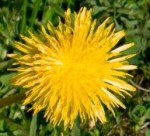 Also known as swine’s snout, Irish daisy, puffball, and peasant’s cloak, dandelion is a herbaceous perennial and a member of the aster family, Asteraceae, that also includes daisy, yarrow, and lettuce. It is native to Europe and Asia but has naturalized throughout the temperate regions of the world including North America and now can be found growing in disturbed soils in all 50 states. The plants grow 6-12″ tall from a long, milky unbranched taproot that is white on the inside and dark brown on the outside. The 2-12″ long dark green leaves have jagged or lobed margins and form ground hugging rosettes that send up 1-10 solitary golden-yellow flower heads 1 1/2- 2″ wide on smooth hallow stems 2-26″ tall beginning in late spring. The flower heads are composed of 40-100 ray flowers that give way to puffy round seed heads containing up to 200 dry, one seeded fruits (achenes). Plants are hardy in zones 1-13 grow well in full sun to part shade and almost any moderately moist soil and are generally considered to be weeds. The common name, dandelion, comes from the Medieval Latin name for the plant , dens lionis, dens meaning tooth and lionis meaning of the lion , and refers to the jagged edges of the leaves. The genus name Taraxacum may come from the Arab word Tharakh chakon meaning bitter herb, or from the Greek word taraxis meaning trouble. The specific epithet, officinale, is the Latin word meaning of shops, and is given to plants that have a real or imagined medicinal value.
Also known as swine’s snout, Irish daisy, puffball, and peasant’s cloak, dandelion is a herbaceous perennial and a member of the aster family, Asteraceae, that also includes daisy, yarrow, and lettuce. It is native to Europe and Asia but has naturalized throughout the temperate regions of the world including North America and now can be found growing in disturbed soils in all 50 states. The plants grow 6-12″ tall from a long, milky unbranched taproot that is white on the inside and dark brown on the outside. The 2-12″ long dark green leaves have jagged or lobed margins and form ground hugging rosettes that send up 1-10 solitary golden-yellow flower heads 1 1/2- 2″ wide on smooth hallow stems 2-26″ tall beginning in late spring. The flower heads are composed of 40-100 ray flowers that give way to puffy round seed heads containing up to 200 dry, one seeded fruits (achenes). Plants are hardy in zones 1-13 grow well in full sun to part shade and almost any moderately moist soil and are generally considered to be weeds. The common name, dandelion, comes from the Medieval Latin name for the plant , dens lionis, dens meaning tooth and lionis meaning of the lion , and refers to the jagged edges of the leaves. The genus name Taraxacum may come from the Arab word Tharakh chakon meaning bitter herb, or from the Greek word taraxis meaning trouble. The specific epithet, officinale, is the Latin word meaning of shops, and is given to plants that have a real or imagined medicinal value.
Although considered a weed, dandelion has many culinary and medicinal value. As early as the tenth-century, Arabian physicians mentioned the plant and by the sixteenth century British pharmacists viewed it as valuable drug. The plant is said to be a diuretic, aid in digestion, and stimulate the appetite and the roots have been used to treat diabetes, liver diseases, anemia, and constipation. All parts of the plant are edible although sometimes bitter; the root is roasted to make a coffee substitute, the flowers are used to make wine that tastes a little like sherry, and the leaves are used as a salad green or cooked and eaten like spinach (but are more nutritious). Although plants were brought to North America as a food source, the flowers can be used to make a yellow dye for wool and the whole plant can be used to make a magenta dye. In addition, the milky sap can be used as a mosquito repellent and to treat warts.